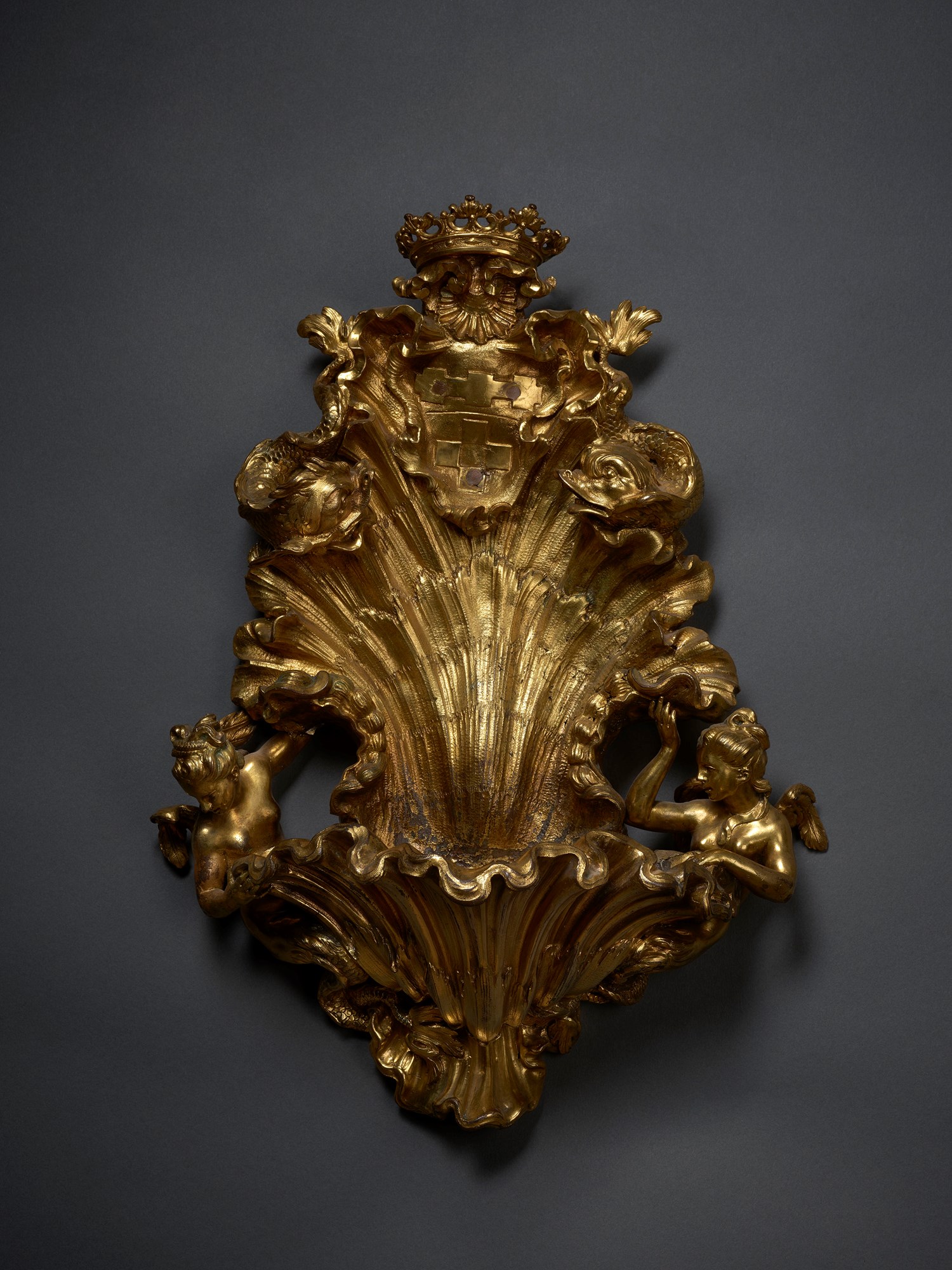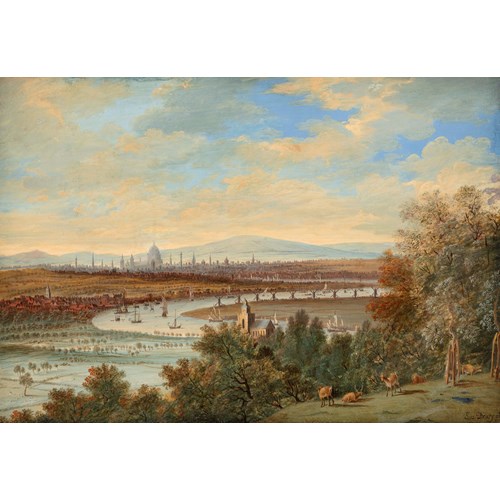Marketplace
A Holy Water Stoup for the Pallavicini Family
Giovanni Giardini
A Holy Water Stoup for the Pallavicini Family
Date c.1710-14
Medium Gilt Copper
Dimension 39 x 25 cm (15³/₈ x 9⁷/₈ inches)
A beautifully cast holy water stoup in the shape of a foliate shell, slightly feathered' in appeal characteristic of many Giardini designs. A pair of winged mermaids grasp the lower lip of the shell, their hair tied in top-knots and the soft bend of their serpentine tails clasping the underside of the font. Two dolphin-faced fish swirl along the up right of the cast, their head turned inward facing the Pallavicini crest, while the tails spread exquisitely behind. Surmounted by a royal crown, presumably of the family, the entire piece, bright with a lovely gilt surface, reflects both the position and aesthetic demand withheld by the Pallavicini family throughout Italy during the 18th century.
A magnificent testament to the Italian genius Giovanni Giardini, the present
gilt copper water stoup exemplifies the artist's expertise in draftsmanship, form and
technical execution. Working from his own designs, available to us today in various
etchings carried out to immortalise his mastery, this impeccable object is clearly
documented in Stella Rudolph's inventory of Niccolo Maria Pallavicini (fig.I). From
this etching we can identify, not only a definitive attribution to Giardini, but an
unquestionable authority in execution. This particular object, recorded in the sacristy
of Pallavicini's private chapel, explains both its importance within the collection and its subsequent escape from the depredations of the Napoleonic army. Identified in the
above mentioned inventory as "un acquasanta di rame gettata dorata dentro, e di
fuori con arma de/ fa signor Marchese" [ a cast copper holy water stoop, gilded inside and outside, with a coat of arms of the late Marchese], we can be certain that our present font is one and the same.
By studying further engravings of Giardini's work, one can see the aesthetic through which he worked, skilfully balancing a strength of form with unfettered movement. One can compare with the present piece similarities in the 'feathered' shell motifs (fig.2), the undulating squirming mythical dolphin-fish (fig.3) and the complete mastery over the balanced human form in varying postures of agility and elegance (figs.3,4,5).
The numerous extant etchings produced of Giardini's private commissions, may
express a further reference to the manner in which he worked. It is documented that Giardini signed a contract in 1712 with the engraver Maximilian Limpach for the plates of the Desegni Diversi, from which the following plates are taken, published in 1714. The commissions to Giardini from Niccolo Maria Pallavicini are dated to the latest period of the art patron's life, who died in 1714. One will notice that the etching referred to here as fig. I, certainly resembles our water font but does not include the Pallavicini family coat of arms. While there are indeed some of the included etchings that do include their arms (figs.4,6,7,8), it can be presumed that the present example was chosen, not to order, but through an existing pattern book that Giardini used for private commissions. In this way, it is not unlikely that the referred to etching was shown to the Pallavicini as an option for their private chapel and was then selected by their approval, after which time the blank shield worked into the
overall design would then be cast with the Pallavicini' s coat of arms. Further to this point, the fact that the dolphin-faced fish in the etching are plumbed, as evidenced by the water that sprouts from their mouths, distinguishes our unplumbed example as a specification withheld to order by the Pallavicini family themselves. This would not be an unusual manner in which to satisfy private orders, especially regarding the amazing popularity and demand for Giardini and his workshop throughout his entire career. Sadly, little of Giardini's masterful skill has come down to us today, adding further importance to our already impressive piece of artistry and skill.
Giovanni Giardini (b Forli, 1646; d Rome, 1721 ) was an Italian draughtsman, silversmith, bronze-caster and gem-carver. Between 1665 and 1668 he was apprenticed to the silversmith Marco Gamberucci (fl 1656--80) in Rome. In 1675 he qualified as a master silversmith and rapidly achieved a position of prestige in the silversmiths' guild. He ran a productive workshop, in which he was joined in 1680 by his brother Alessandro Giardini (b 1655). In 1698 he was appointed bronze-founder for the Papacy. Only a few of his works in silver have survived, most of them church furnishings that escaped the depredations of the Napoleonic army. These show a strong sense of form and a technical mastery that earned him important commissions from the papal court, including an imposing papal mace in silver and parcel-gilt (c. 1696; London, V&A), a tabernacle in silver, gilt copper, porphyry and rock-crystal (1711; Vienna, Ksthist. Mus.) and a cross and two candlesticks in silver and malachite (1720; Pavia, priv. col.), which were made for the chapel of Cardinal Francesco Barberini in St Peter's, Rome. When the body of Queen Christina of Sweden was exhumed in 1965 in St Peter's, a set of pieces by Giardini was found: the Queen's silver sceptre, crown and funerary mask of 1689 (Rome, St Peter's). Giardini's reputation, however, is based on his pattern-book designs for sacred and secular objects, which were engraved on copper by Maximilian Limpach of Prague and published in Prague in 1714 as Disegni diversi. They were reprinted in Rome in 1750 with the title Promptuarium artis argentariae. This is the finest I 8th-century collection of patterns for silversmiths. The objects are divided into different types, with varied and original decorative designs. They reflect the influence of late Baroque sculpture and architecture, especially the work of Bernini and Francesco Borromini from which they derive their long curving lines and their repertory of naturalistic ornament. Although many of Giardini's patterns represent pure caprices that would be difficult to execute in precious metal, they were the most important source of inspiration for Roman artistic silver production throughout the 18th century, and they continued to be influential into the 19th.
A magnificent testament to the Italian genius Giovanni Giardini, the present
gilt copper water stoup exemplifies the artist's expertise in draftsmanship, form and
technical execution. Working from his own designs, available to us today in various
etchings carried out to immortalise his mastery, this impeccable object is clearly
documented in Stella Rudolph's inventory of Niccolo Maria Pallavicini (fig.I). From
this etching we can identify, not only a definitive attribution to Giardini, but an
unquestionable authority in execution. This particular object, recorded in the sacristy
of Pallavicini's private chapel, explains both its importance within the collection and its subsequent escape from the depredations of the Napoleonic army. Identified in the
above mentioned inventory as "un acquasanta di rame gettata dorata dentro, e di
fuori con arma de/ fa signor Marchese" [ a cast copper holy water stoop, gilded inside and outside, with a coat of arms of the late Marchese], we can be certain that our present font is one and the same.
By studying further engravings of Giardini's work, one can see the aesthetic through which he worked, skilfully balancing a strength of form with unfettered movement. One can compare with the present piece similarities in the 'feathered' shell motifs (fig.2), the undulating squirming mythical dolphin-fish (fig.3) and the complete mastery over the balanced human form in varying postures of agility and elegance (figs.3,4,5).
The numerous extant etchings produced of Giardini's private commissions, may
express a further reference to the manner in which he worked. It is documented that Giardini signed a contract in 1712 with the engraver Maximilian Limpach for the plates of the Desegni Diversi, from which the following plates are taken, published in 1714. The commissions to Giardini from Niccolo Maria Pallavicini are dated to the latest period of the art patron's life, who died in 1714. One will notice that the etching referred to here as fig. I, certainly resembles our water font but does not include the Pallavicini family coat of arms. While there are indeed some of the included etchings that do include their arms (figs.4,6,7,8), it can be presumed that the present example was chosen, not to order, but through an existing pattern book that Giardini used for private commissions. In this way, it is not unlikely that the referred to etching was shown to the Pallavicini as an option for their private chapel and was then selected by their approval, after which time the blank shield worked into the
overall design would then be cast with the Pallavicini' s coat of arms. Further to this point, the fact that the dolphin-faced fish in the etching are plumbed, as evidenced by the water that sprouts from their mouths, distinguishes our unplumbed example as a specification withheld to order by the Pallavicini family themselves. This would not be an unusual manner in which to satisfy private orders, especially regarding the amazing popularity and demand for Giardini and his workshop throughout his entire career. Sadly, little of Giardini's masterful skill has come down to us today, adding further importance to our already impressive piece of artistry and skill.
Giovanni Giardini (b Forli, 1646; d Rome, 1721 ) was an Italian draughtsman, silversmith, bronze-caster and gem-carver. Between 1665 and 1668 he was apprenticed to the silversmith Marco Gamberucci (fl 1656--80) in Rome. In 1675 he qualified as a master silversmith and rapidly achieved a position of prestige in the silversmiths' guild. He ran a productive workshop, in which he was joined in 1680 by his brother Alessandro Giardini (b 1655). In 1698 he was appointed bronze-founder for the Papacy. Only a few of his works in silver have survived, most of them church furnishings that escaped the depredations of the Napoleonic army. These show a strong sense of form and a technical mastery that earned him important commissions from the papal court, including an imposing papal mace in silver and parcel-gilt (c. 1696; London, V&A), a tabernacle in silver, gilt copper, porphyry and rock-crystal (1711; Vienna, Ksthist. Mus.) and a cross and two candlesticks in silver and malachite (1720; Pavia, priv. col.), which were made for the chapel of Cardinal Francesco Barberini in St Peter's, Rome. When the body of Queen Christina of Sweden was exhumed in 1965 in St Peter's, a set of pieces by Giardini was found: the Queen's silver sceptre, crown and funerary mask of 1689 (Rome, St Peter's). Giardini's reputation, however, is based on his pattern-book designs for sacred and secular objects, which were engraved on copper by Maximilian Limpach of Prague and published in Prague in 1714 as Disegni diversi. They were reprinted in Rome in 1750 with the title Promptuarium artis argentariae. This is the finest I 8th-century collection of patterns for silversmiths. The objects are divided into different types, with varied and original decorative designs. They reflect the influence of late Baroque sculpture and architecture, especially the work of Bernini and Francesco Borromini from which they derive their long curving lines and their repertory of naturalistic ornament. Although many of Giardini's patterns represent pure caprices that would be difficult to execute in precious metal, they were the most important source of inspiration for Roman artistic silver production throughout the 18th century, and they continued to be influential into the 19th.
Date: c.1710-14
Medium: Gilt Copper
Dimension: 39 x 25 cm (15³/₈ x 9⁷/₈ inches)
Provenance: Marchese Niccolò Maria Pallavicini collection, Rome, early 18th century
Literature: C. G. Bulgari: Argentieri, gemmari e oraji d'ltalia, i (Rome, 1958)
S. Fornari: Argenti romani (Rome, 1969)
H. Honour: Oraji e argentieri (Milan, 1972)
S. Rudolph: Niccolo Maria Pal/avicini; l 'ascesa al tempio de/la virtu attraverso ii mecanatismo, Rome, 1995.
Plus d'œuvres d'art de la Galerie






_T638676151429242934.jpg?width=500&height=500&mode=pad&scale=both&qlt=90&format=jpg)


